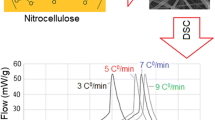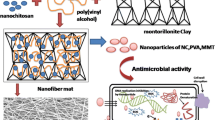Abstract
Polymeric nanofibers have gained a great deal of attention in recent years. This study aims to produce and evaluate a methylcellulose (MC) and polyvinyl alcohol (PVA) based nanofibers mat using the electrospinning process. 25–2 fractional factorial screening design has been used to study the effect of critical formulation and process parameters, such as concentration of MC (%), the concentration of PVA (%), applied Voltage (kV), distance (cm), flow rate (ml/hr) on the critical quality attributes like fiber diameter, tensile strength, and morphology. The fiber morphology and fiber diameter of nanofibers were investigated by scanning electron microscopy (SEM).s The optimized nanofibers mat was further characterized by Fourier transform infrared (FTIR) spectroscopy, Differential scanning electrons (DSC), Thermal gravimetric analysis (TGA), X-ray diffraction (XRD), Atomic force microscopy (AFM). Parameters such as contact angle and rate of biodegradation were studied for an optimized batch. The SEM results showed the uniform morphology of optimized nanofibers without beads with fiber diameter in the range of 100–200 nm. FTIR analysis demonstrated good intermolecular interactions between the molecules of MC with PVA. DSC-TGA study showed good thermal properties of nanofibers. XRD study showed the crystalline nature of nanofibers. Maximum tensile strength up to 2.74 Mpa was obtained which is desired for drug delivery application. The exaggeration of the fiber diameter was measured by AFM and found good surface morphology. Furthermore, results of contact angle and biodegradation rate proved that prepared nanofibers would be considered as a suitable carrier for controlled drug delivery applications like wound healing.
Graphic abstract

















Similar content being viewed by others
Abbreviations
- MC:
-
Methyl cellulose
- PVA:
-
Poly vinyl Alcohol
- PCL:
-
Polycaprolactone
- PVP:
-
Polyvinylpyrrolidone
- NFs:
-
Nanofiber
- KBr:
-
Potassium Bromide
- Wt:
-
Weight
- µg:
-
Micro gram
- Mg:
-
Milligram
- G:
-
Gram
- mL:
-
Milliliter
- Mm:
-
Millimeter
- Cm:
-
Centimeter
- sec.:
-
Second
- min.:
-
Minute
- hr.:
-
Hours
- °C:
-
Degree centigrade
- %:
-
Percentage
- ± :
-
Plus or Minus
- e.g.:
-
For example
- Sr. No.:
-
Serial number
- DSC:
-
Differential scanning calorimetry
- TGA:
-
Thermogravimetry analysis
- Nm:
-
Nanometer
- RH:
-
Relative Humidity
- SEM:
-
Scanning Electron Microscope
- FTIR:
-
Fourier Transmittance Infrared
- AFM:
-
Atomic force microscopy
References
Sofi HS, Abdal-hay A, Ivanovski S (2020) Electrospun nanofibers for the delivery of active drugs through nasal, oral and vaginal mucosa: Current status and future perspectives. Mater Sci Eng 111:110756
Feng X, Li J, Zhang X et al (2019) Electrospun polymer micro/nanofibers as pharmaceutical repositories for healthcare. J Control Release 302:19–41
Venugopal J, Ramakrishna S (2005) Applications of polymer nanofibers in biomedicine and biotechnology. Appl Biochem Biotechnol–Part A Enzym Eng Biotechnol 125:147–157
Topuz F, Uyar T (2019) Electrospinning of cyclodextrin functional nanofibers for drug delivery applications. Pharmaceutics 11(1):6
Hu X, Liu S, Zhou G et al (2014) Electrospinning of polymeric nanofibers for drug delivery applications. J Control Release 185:12–21
Alghoraibi I, Alomari S (2018) Different Methods for Nanofiber Design and Fabrication. In: Handbook of Nanofibers. pp 1–46
Li S, Lee BK (2020) Electrospinning of circumferentially aligned polymer nanofibers floating on rotating water collector. J Appl Polym Sci. https://doi.org/10.1002/app.48759
Kurečič M, Smole MS (2013) Elektropredenje: Postopek izdelave nanovlaken. Tekstilec 56:4–12. https://doi.org/10.14502/Tekstilec2013.56.4-12
Chahal S, Hussain FSJ, Kumar A et al (2016) Fabrication, characterization and in vitro biocompatibility of electrospun hydroxyethyl cellulose/poly (vinyl) alcohol nanofibrous composite biomaterial for bone tissue engineering. Chem Eng Sci 144:17–29. https://doi.org/10.1016/j.ces.2015.12.030
Chahal S, Hussain FSJ, Yusoff MM et al (2017) Nanohydroxyapatite-coated hydroxyethyl cellulose/poly (vinyl) alcohol electrospun scaffolds and their cellular response. Int J Polym Mater Polym Biomater 66:115–122. https://doi.org/10.1080/00914037.2016.1190926
Guo JJ, Kelton CML (2016) Competition between brand name and generic drugs. In: Pharmaceutical Public Policy. pp 181–193
Dutta SD, Patel DK, Lim KT (2019) Functional cellulose-based hydrogels as extracellular matrices for tissue engineering. J. Biol, Eng, p 13
Yuwawech K, Wootthikanokkhan J, Tanpichai S (2015) Effects of two different cellulose nanofiber types on properties of poly(vinyl alcohol) composite films. J Nanomater. https://doi.org/10.1155/2015/908689
Mueller S, Sapkota J, Nicharat A et al (2015) Influence of the nanofiber dimensions on the properties of nanocellulose/poly(vinyl alcohol) aerogels. J Appl Polym Sci. https://doi.org/10.1002/app.41740
Kenry LCT (2017) Nanofiber technology: current status and emerging developments. Prog Polym Sci 70:1–17
Lin CM, Chang YC, Cheng LC et al (2020) Preparation of graphene-embedded hydroxypropyl cellulose/chitosan/polyethylene oxide nanofiber membranes as wound dressings with enhanced antibacterial properties. Cellulose 27:2651–2667. https://doi.org/10.1007/s10570-019-02940-w
Eskitoros-Togay M, Bulbul YE, Dilsiz N (2020) Combination of nano-hydroxyapatite and curcumin in a biopolymer blend matrix: Characteristics and drug release performance of fibrous composite material systems. Int J Pharm. https://doi.org/10.1016/j.ijpharm.2020.119933
Patel GC, Yadav BK (2018) Polymeric nanofibers for controlled drug delivery applications. In: Organic Materials as Smart Nanocarriers for Drug Delivery. pp 147–175
Patel G, Yadav BKN (2019) Formulation, characterization and in vitro cytotoxicity of 5-fluorouracil loaded polymeric electrospun nanofibers for the treatment of skin cancer. Recent Pat Nanotechnol 13:114–128. https://doi.org/10.2174/1872210513666190314095643
Vora R, Shah Y (2019) Investigation of quality target process parameters and critical material attributes of nanocellulose as a potential excipient. Int J Appl Pharm 11:386–395
Deepa B, Abraham E, Cherian BM et al (2011) Structure, morphology and thermal characteristics of banana nano fibers obtained by steam explosion. Bioresour Technol 102:1988–1997. https://doi.org/10.1016/j.biortech.2010.09.030
Širc J, Hobzová R, Kostina N et al (2012) Morphological characterization of nanofibers: Methods and application in practice. J Nanomater. https://doi.org/10.1155/2012/327369
Baker SR, Banerjee S, Bonin K, Guthold M (2016) Determining the mechanical properties of electrospun poly-ε-caprolactone (PCL) nanofibers using AFM and a novel fiber anchoring technique. Mater Sci Eng C 59:203–212. https://doi.org/10.1016/j.msec.2015.09.102
Molnar K, Vas LM, Czigany T (2012) Determination of tensile strength of electrospun single nanofibers through modeling tensile behavior of the nanofibrous mat. In: Composites Part B: Engineering. pp 15–21
Sundarkrishnaa KL (2015) Design of experiments. Springer Ser Mater Sci 171:193–203. https://doi.org/10.1007/978-3-319-14069-8_5
Hinkelmann K (2012) Design and Analysis of Experiments
Anderson-Cook CM, Borror CM, Montgomery DC (2009) Response surface design evaluation and comparison. J Stat Plan Inference 139:629–641. https://doi.org/10.1016/j.jspi.2008.04.004
Mohamad Said KA, Mohamed Amin MA (2016) Overview on the response surface methodology (rsm) in extraction processes. J Appl Sci Process Eng. https://doi.org/10.33736/jaspe.161.2015
Keane AJ (2006) Statistical improvement criteria for use in multiobjective design optimization. AIAA J 44:879–891. https://doi.org/10.2514/1.16875
Ghosal K, Manakhov A, Zajíčková L, Thomas S (2017) Structural and surface compatibility study of modified electrospun Poly(ε-caprolactone) (PCL) composites for skin tissue engineering. AAPS PharmSciTech 18:72–81. https://doi.org/10.1208/s12249-016-0500-8
Saba N, Safwan A, Sanyang ML et al (2017) Thermal and dynamic mechanical properties of cellulose nanofibers reinforced epoxy composites. Int J Biol Macromol 102:822–828. https://doi.org/10.1016/j.ijbiomac.2017.04.074
Yan SH, Ma SY, Li WQ et al (2015) Synthesis of SnO2-ZnO heterostructured nanofibers for enhanced ethanol gas-sensing performance. Sensors Actuators B Chem 221:88–95. https://doi.org/10.1016/j.snb.2015.06.104
Johnson D, Oatley-Radcliffe DL, Hilal N (2017) Atomic Force Microscopy (AFM). In: Membrane Characterization. pp 115–144
Nadour M, Boukraa F, Ouradi A, Benaboura A (2017) Effects of methylcellulose on the properties and morphology of polysulfone membranes prepared by phase inversion. Mater Res 20:339–348. https://doi.org/10.1590/1980-5373-MR-2016-0544
Babaee M, Jonoobi M, Hamzeh Y, Ashori A (2015) Biodegradability and mechanical properties of reinforced starch nanocomposites using cellulose nanofibers. Carbohydr Polym 132:1–8. https://doi.org/10.1016/j.carbpol.2015.06.043
Song W, Markel DC, Wang S et al (2012) Electrospun polyvinyl alcohol-collagen-hydroxyapatite nanofibers: A biomimetic extracellular matrix for osteoblastic cells. Nanotechnology. https://doi.org/10.1088/0957-4484/23/11/115101
Chanda A, Adhikari J, Ghosh A et al (2018) Electrospun chitosan/polycaprolactone-hyaluronic acid bilayered scaffold for potential wound healing applications. Int J Biol Macromol. https://doi.org/10.1016/j.ijbiomac.2018.05.099
Croisier F, Atanasova G, Poumay Y, Jérôme C (2014) Polysaccharide-coated pcl nanofibers for wound dressing applications. Adv Healthc Mater. https://doi.org/10.1002/adhm.201400380
Haider A, Haider S, Kang IK (2018) A comprehensive review summarizing the effect of electrospinning parameters and potential applications of nanofibers in biomedical and biotechnology. Arab J Chem 11:1165–1188
Abd El-aziz AM, El-Maghraby A, Taha NA (2017) Comparison between polyvinyl alcohol (PVA) nanofiber and polyvinyl alcohol (PVA) nanofiber/hydroxyapatite (HA) for removal of Zn2+ ions from wastewater. Arab J Chem 10:1052–1060. https://doi.org/10.1016/j.arabjc.2016.09.025
Park Y, You M, Shin J et al (2019) Thermal conductivity enhancement in electrospun poly(vinyl alcohol) and poly(vinyl alcohol)/cellulose nanocrystal composite nanofibers. Sci Rep. https://doi.org/10.1038/s41598-019-39825-8
Peresin MS, Vesterinen AH, Habibi Y et al (2014) Crosslinked PVA nanofibers reinforced with cellulose nanocrystals: Water interactions and thermomechanical properties. J Appl Polym Sci. https://doi.org/10.1002/app.40334
Kumar A, Negi YS, Bhardwaj NK, Choudhary V (2012) Synthesis and characterization of methylcellulose/PVA based porous composite. Carbohydr Polym 88:1364–1372. https://doi.org/10.1016/j.carbpol.2012.02.019
Kanimozhi K, Basha SK, Kaviyarasu K, SuganthaKumari V (2019) Salt leaching synthesis, characterization and in vitro cytocompatibility of chitosan/poly(vinyl alcohol)/methylcellulose – ZnO nanocomposites scaffolds using L929 fibroblast cells. J Nanosci Nanotechnol 19:4447–4457. https://doi.org/10.1166/jnn.2019.16359
Kanimozhi K, Khaleel Basha S, Sugantha Kumari V (2016) Processing and characterization of chitosan/PVA and methylcellulose porous scaffolds for tissue engineering. Mater Sci Eng C 61:484–491. https://doi.org/10.1016/j.msec.2015.12.084
Kanimozhi K, Khaleel Basha S, Sugantha Kumari V et al (2018) In vitro cytocompatibility of chitosan/PVA/methylcellulose – Nanocellulose nanocomposites scaffolds using L929 fibroblast cells. Appl Surf Sci 449:574–583. https://doi.org/10.1016/j.apsusc.2017.11.197
Bhatnagar A, Sain M (2005) Processing of cellulose nanofiber-reinforced composites. J Reinf Plast Compos 24:1259–1268. https://doi.org/10.1177/0731684405049864
Kumar A, Negi YS, Bhardwaj NK, Choudhary V (2013) Synthesis and characterization of cellulose nanocrystals/PVA based bionanocomposite. Adv Mater Lett 4:626–631. https://doi.org/10.5185/amlett.2012.12482
Acknowledgement
The authors are thankful to Ramanbhai Patel College of Pharmacy, Charotar University of Science and Technology (CHARUSAT) for extended financial support to carry out this research work.
Funding
Declared none.
Author information
Authors and Affiliations
Corresponding author
Ethics declarations
Conflict of interest
The authors declare that they have no conflict of interest.
Consent for publication
Not applicable.
Additional information
Publisher's Note
Springer Nature remains neutral with regard to jurisdictional claims in published maps and institutional affiliations.
Rights and permissions
About this article
Cite this article
Yadav, B.K.N., Patel, G.C. Fabrication and characterization of coblended methyl cellulose with polyvinyl alcohol electrospun nanofibers as a carrier for drug delivery system. Polym. Bull. 79, 4069–4097 (2022). https://doi.org/10.1007/s00289-021-03659-0
Received:
Revised:
Accepted:
Published:
Issue Date:
DOI: https://doi.org/10.1007/s00289-021-03659-0




